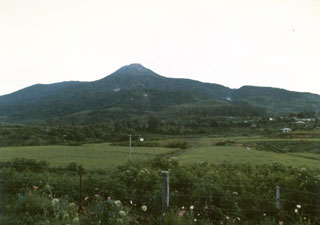Report on Talang (Indonesia) — October 2001
Bulletin of the Global Volcanism Network, vol. 26, no. 10 (October 2001)
Managing Editor: Richard Wunderman.
Talang (Indonesia) Increase in volcanic and seismic activity during 24-30 September 2001
Please cite this report as:
Global Volcanism Program, 2001. Report on Talang (Indonesia) (Wunderman, R., ed.). Bulletin of the Global Volcanism Network, 26:10. Smithsonian Institution. https://doi.org/10.5479/si.GVP.BGVN200110-261160
Talang
Indonesia
0.979°S, 100.681°E; summit elev. 2575 m
All times are local (unless otherwise noted)
The last reported activity at Talang occurred in October 1986 (minor steam explosions). Talang was relatively quiet after that, until September 2001, when the Volcanological Survey of Indonesia (VSI) reported an increase in activity. On 25 September 2001 the volcano ejected a "white thick-brownish" plume that rose 200-350 m. That evening, a sulfur smell was noticed at the post observatory. Temperatures at Batu Bajanjang hot spring and the fumarole fields at Gabuo Atas and Gabuo Bawah increased (table 1). The water level at Batu Bajanjang decreased drastically.
Table 1. Comparison of temperatures of various locations at Talang during 2000 and 2001. Courtesy of VSI.
| Location | 2000 Temperature | 2001 Temperature |
| Hot Spring | 40-60°C | 45-66°C |
| Gabuo Atas field | 98-99°C | 111-114°C |
| Gabuo Bawah field | 96-99°C | 100-101°C |
Because of a broken seismograph, seismicity at Talang could not be observed until 3 October. During 1-7 October, Talang was dominated by tectonic earthquakes. A thin-white plume reached 50-100 m above the summit. VSI reported four deep volcanic (A-type) events, two shallow volcanic (B-type) events, and 18 tectonic earthquakes. Talang volcano is at Alert Level 2 (on a scale of 1-4).
Geological Summary. Talang is part of a large volcanic edifice just NW of Dibawah Lake. An older volcanic peak, Pasar Arbaao, is ~1.5 km W. The steep-sided Talang cone exhibits fumarolic activity but has no crater; it appears to have grown within a larger caldera. Recorded eruptions have mostly involved small-to-moderate explosive activity, first documented in the 19th century, that originated from a series of small craters in a valley on the NE flank.
Information Contacts: Dali Ahmad, Volcanological Survey of Indonesia (VSI), Jalan Diponegoro No.57, Bandung 40122, Indonesia (URL: http://www.vsi.esdm.go.id/).

